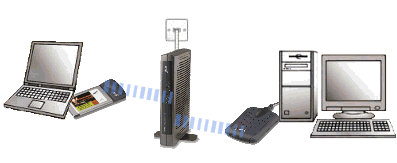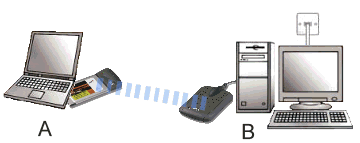Networking
A network is two or more computers connected together sharing Internet connection, files and peripheral devices such as printers. Your wireless router allows your computers to connect to the Internet without wires. This lets you move a laptop computer around while staying connected to the Internet or lets you locate a desktop computer in a room that cannot easily be reached with cables.
Your wireless router forms an Infrastructure wireless network.
Infrastructure Network
In the infrastructure network a Base Unit is used as the central point of all communications and acts as a gateway to the Internet. The Internet connection is automatically shared between all computers associated with the Base Unit. As a result, laptop or desktop computers on your wireless network can connect to the Internet as if they were directly plugged into the ADSL socket.
Ad-Hoc Network
You router creates an Infrastructure Network which is the most efficient way to share an Internet connection. For information, this section describes the other type of wireless network, the ad-hoc network, also known as peer-to-peer network.
In the ad-hoc network, computers communicate between one another without the need for a Base Unit. Windows’ Internet Connection Sharing can be used to share an Internet connection available on one computer between all computers on the network. At least one computer must already be connected to the Internet and be switched-on for other computers to access the Internet.
In the example below, computer B is connected to the Internet and equipped with a wireless Adapter. Computer A, equipped with a wireless Adapter also that can share the Internet connection using Windows Internet Connection Sharing running on computer B.
Wireless Network Settings
- A Wireless Network is defined by the following settings:
- Wireless Network Name (SSID): Identifies your wireless network.
- Channel: Wireless Networks operate in the 2.4GHz frequency band where 14 channels are available. Devices must operate on the same channel to be able to communicate. In an infrastructure network, the Base Unit controls the channel allocation.
- Security: You can use Hidden Name (Hidden SSID), WEP (Wired Equivalent Privacy) or WPA (Wi-Fi Protected Access) mechanisms to ensure the integrity of the network


